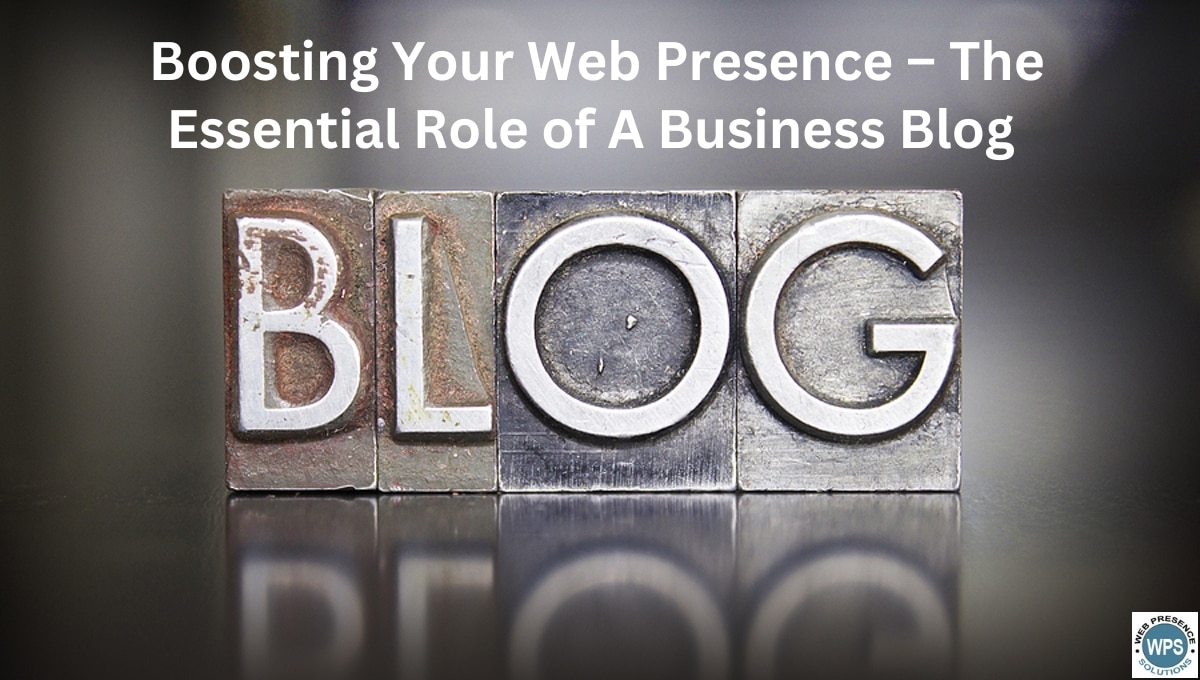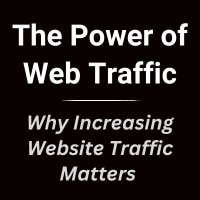We have heard a question more than a few times here at Web Presence Solutions: “I have a business website; do I need a blog for my business?”
A related question is, “Should a blog be part of my business marketing strategy?”
Our answer is almost always: “Yes, you should have a blog on your website and as part of your marketing strategy.”
In the age of digital marketing, having a business website isn’t enough. A blog is essential to connect with your audience, customers, and sales prospects.
Why? Because a blog isn’t just a platform for words; it’s a strategic tool that can propel your brand to new heights.
According to BrightEdge, an enterprise SEO marketing company, and based on research conducted in August of 2023:
“Blogs are the most prevalent form of content found in the top 10 search engine rankings, excluding home pages. This robust presence of blogs signifies their vital role in an effective SEO strategy.” (Source: BrightEdge)

Before going further, let’s clarify the definition of a blog and blog posts.
What is a blog?
A blog is a regularly updated online platform where individuals or businesses share information, insights, and opinions on various topics. It is comprised of individual blog posts or articles.
A blog can be a standalone website comprised entirely of blog posts, but frequently, a blog is a section of a more extensive business website.
In the context of a business marketing strategy, a business blog is a powerful tool to establish authority, build trust, and engage with the target audience. This can be particularly true for a new business or a small business blog.
What is a blog post?
A blog post is a digital article or entry published on a website blog, typically focused on a specific topic or subject.
Much like newspapers and magazines that are comprised of articles, a blog contains individual blog posts.
Blog posts can vary in length and style, from short updates to in-depth analyses. They often include multimedia elements like images, videos, and links to enhance the content.
The most well-known platform for blogging is WordPress. It is best described as a content management system (CMS). Here are a couple of facts about WordPress:
- WordPress powers over 43.2% of the internet (Source: W3Techs).
- Roughly 70 million new posts are published on WordPress each month (Source: WordPress).
Why Have A Blog For Your Business Website?
Here are six key reasons for having a business website blog. Each section is expanded further within this post.
- Growing Website Traffic
- Elevating Visitors Engagement
- Building Authority and Trust
- Fueling Social Media and Email Marketing
- Enhancing SEO Through Inbound Links
- Nurturing Leads
1. Growing Website Traffic Through A Business Blog
A blog is an excellent way to attract website visitors and drive potential customers to your site. Here are some steps you can take when leveraging your business blog:
1. Promote links to your blog posts via social media and email marketing.
2. Grow search engine traffic from the more diverse keywords in your blog posts.
3. Improve your business search engine visibility by creating a growing body of regularly updated website content on many new topics.
4. Increase the number of returning visits from people who return to your site to read new blog posts.
5. Gain new website visitors from people who share a link to a blog post with a friend or colleague.
Create well-written, exciting, and engaging content relevant to your target market so people will read it. A percentage of those people will return later as new blog content is published.
Moreover, a related question is, “How many new potential customers will a blog bring to my website that would never have visited without a blog.” A range of studies have confirmed the impact of a blog on increasing website traffic.
The number of new and returning visitors to your website and blog will depend on the quality of your blog content and whether it provides value to your visitors. So, focus on quality over quantity.
Tips On How To Promote Your Business Blog
Increased website traffic will also be a function of expanding the visibility of your blog content. A variety of promotional tactics can be used for building blog post visibility, including:
- Directly promoting your blog and blog posts within your other website content.
- Sharing your blog content via social media.
- Promoting your blog content via email marketing.
- Building visibility for your blog content with existing customers.
- Creating engaging, relevant, and valuable content your readers will want to share.
- Publishing content that is structured to make it easy for the search engines to find, understand, and display.
Building an Expanded Number of Relevant Keywords
Blog posts also provide a significant opportunity for your website to rank for a wide range of keywords relevant to your business. As the number of posts on your business blog increases, so does the number of new keywords that search engines will find within your blog posts.
Over time, your blog posts can start to gain higher rankings for a broader array of less competitive long-tail keywords, thus generating more links and bringing more traffic to your site.
Necessary: Have realistic expectations. Growth in traffic does not happen overnight, and it does not take off after only a couple of blog posts. This is a longer-term strategy, not a “quick fix.”
2. Increasing Website Visitor Engagement
Blog posts are not solely about getting more business website traffic. Well-written blog content can also create engagement.
Engaging visitors on your website is a crucial element of online success, and a blog can be a vital part of an engagement strategy, which can lead to:
- Satisfied visitors
- Longer visits
- Return visits in the future
- Increased conversions
- More sales and referrals
For example, on a typical ecommerce website, only 1-3% of people who visit a website for the first time are ready to purchase during that specific visit. Providing reasons for a visitor to return helps build conversions and sales.
The days of “just get someone to the website and take their order” are gone. For any business that wants to be truly successful on the Internet in the long run, visitor engagement is critical.
Here is a graphic illustrating the different steps from creating more content to fostering more traffic and engagement through building conversions, generating more leads, and closing more sales.

Quality content is the glue fostering engagement, which leads to conversions and sales.
Keeping people engaged on your website and social media properties will allow you to develop a stronger relationship with visitors, customers, prospects, and business partners.
This will increase conversion rates and bring visitors back to your website and social media properties on an ongoing basis.
3. Building Authority and Trust
A blog shows people that you and your business know what you are talking about. It allows your business to provide website visitors with more insights and perspectives on your products and services, who you are, and how you do business.
Yet, unlike most forms of social media, blog posts can
- Provide more significant amounts of information through longer posts.
- Be easily accessible on your website long term for easy future access
- Remain visible and not be quickly buried by new posts, tweets, pins, etc.
“The average blog post length is 1427 words long. 2023″ Most bloggers publish articles in the 500-1500 word range (Source: Orbit Media)
The broader format of a business blog also creates the opportunity to educate and provide greater detail and information on your products, services, and business that might not fit effectively on a specific Products page, Services page, or About Us page.
This can be particularly true with a small business blog.
The enhanced levels of detail and information allow you to position your business as an authority in your niche or industry and someone trustworthy to deliver the products or services you sell.
The more visitors trust and respect your business, the more likely they will buy from you, now and in the future.

4. Fueling Social Media and Email Marketing
Blog posts are useful content assets for your social media and email marketing strategy. Well-written blog posts will:
- Provide shareable content for driving your social media campaigns.
- Offer strong content for enhancing your email marketing campaigns.
- Build visibility and brand awareness through other people sharing your content via different social media channels.
- Drive traffic to your website and blog post pages from visitors sharing your content via social media sharing from your website.
Social Sharing Opportunities
Once a new blog post is created, it can be promoted through all your social media channels. The strategies and sharing frequency will vary depending on the social media platform.
For example, on Twitter, you can come up with several different Tweets about each blog post. Then tweet them out a few (several?) times a day for the first few days, then once or twice a day for the next few days.
Regardless of the posting frequency, your blog content will provide quality content to help grow your social media presence. Your blog can help feed your social media accounts, and your social media accounts can deliver traffic to your blog.
Email Marketing Content From Blog Posts
Some businesses wrestle with the questions,
- “Where can I get quality content to use in my email marketing campaigns?”
- And “I don’t want to always have to send out discount offers just to have an email campaign.”
A business website blog is an excellent content source for email marketing campaigns, especially for a small business blog with a limited marketing budget.
A snippet of a blog post and a link to the full post can be added to email marketing campaigns. Email campaigns can also be created that only include blog posts snippets and links to content from your business blog.
Email List Growth: Besides providing content for use in emails, your blog also offers an excellent opportunity to grow your email list. Delivering real value through your blog content will directly increase the number of visitors signing up for your email list. The key is to make it easy and obvious for visitors to sign up.
More Blog Posts – More Content Assets to Share
Regardless of which channel you are using your blog content for, you will have an expanding amount of content as your blog grows. And blog posts have a lengthy lifespan. It is not unusual to see people share a quality blog post written 1-2 years earlier or more.
Social sharing buttons on your blog will encourage people to share your content directly from your website. Including social sharing buttons in your email campaigns will enable subscribers to share your email content.
Enhancing SEO Through Inbound Links (Backlinks)
Quality blog content provides an excellent opportunity to build incoming links to your website that can generate additional website traffic and visitors (sales prospects).
Additionally, a growing number of backlinks enhances your website’s SEO and is a positive signal to Google. Potentially improving search engine ranking over time.
Some common ways that inbound links to your business blog content can grow over time include:
- Visitors sharing content through their social media account
- Blog reader emailing a link to a friend or business contact.
- Another writer including a mention and link to your blog post in a blog post on their website.
The opportunity to develop a growing number of inbound links will be directly influenced by how well you promote your blog posts. And by the quality of your blog content.
Sharing your posts with a link on Twitter, Facebook, Instagram, TikTok, LinkedIn, Google Business Profile, Pinterest, and other social media platforms will build visibility, incoming links, and website traffic.
“Our analysis shows that blogs naturally possess key features that enhance their SEO performance. These SEO-friendly traits are often built into the blog software itself.” (Source: BrightEdge)
Nurturing Leads With Website Blog Content
In the vast digital marketplace, attracting visitors to your website is the first step. The real challenge lies in converting these visitors into loyal customers.
This is where a business blog plays a pivotal role. A well-structured blog is a platform to nurture potential customers, guiding them meticulously through their buyer’s journey. Elements of the nurturing process include:
- Educational Content: You position your brand as a trusted resource by offering educational content that addresses your target audience’s pain points and queries. This captures the interest of potential customers and keeps them engaged, returning for more insights.
- Building Trust: Regularly updating your blog with valuable content establishes credibility. Over time, readers begin to trust your brand, viewing it as an industry authority. This trust is crucial in nudging potential customers closer to a purchase decision.
- Personalized Engagement: Blogs allow for personalized engagement through tailored content, addressing specific segments of your audience. By catering to the unique needs and preferences of different customer personas, you can guide them through the various stages of the sales funnel.
- Call-to-Action Integration: Strategically placing calls-to-action (CTAs) within your blog posts can direct readers to take specific actions, be it signing up for a newsletter, downloading a resource, or making a purchase. These CTAs serve as gentle nudges, guiding potential customers toward conversion.
A blog isn’t just about sharing information; it’s a strategic tool designed to attract, engage, and convert visitors into loyal customers. By understanding and addressing the needs of your audience, you can effectively nurture leads, paving the way for sustained business growth.”

The Blogging world continues to Evolve – Rapidly
One of the most significant evolutionary steps in blogging is the rapid growth of artificial intelligence (AI). With the release of ChatGPT from OpenAI in 2023, the number, quality, and scope of content creation tools have skyrocketed.
The current leading players in AI fuel content creation include:
- OpenAI with ChatGPT and Dall-E
- Google with their Bard AI tool
- Anthropic with Claude-2
- And Microsoft’s AI relationship with OpenAI and use of ChatGPT within Bing
According to recent statistics about the use of AI in blogging, according to Orbit Media
- “Bloggers have embraced AI at an incredible rate. 65% of bloggers use AI to varying degrees.
- “The most common use case is generating ideas (43%).”
- “The other most common uses are to write headlines and outlines.”
One thing is sure: the integration and usage of AI for blogging purposes will continue to grow.
At the same time, the power of blogs and blogging continues to endure. Again, according to BrightEdge:
“In essence, while many digital trends come and go, blogs have maintained their pivotal role in SEO. Our findings validate their undiminished importance, urging brands to recognize and harness their potential for sustained digital success.”
Conclusions and Next Steps:
We’ve touched on six reasons for having a business blog on your website. The most significant reason is to provide value to customers, sales prospects, and business partners while telling more of your business story indirectly and subtly.
As a result, the time and effort in maintaining a blog will undoubtedly pay off through increased brand awareness, customer engagement, and improved search engine rankings. This is true for both large business and small business blogs.
A blog serves as a platform to showcase your expertise, share insights, and address common concerns or questions your audience might have. It’s not just about driving traffic; it’s about building trust and establishing your brand as an authority in your industry.
Moreover, with the ever-evolving digital landscape, having fresh and relevant content on your website is crucial for SEO. Search engines favor websites that are updated regularly with valuable content.
Remember, a blog is more than just a marketing tool; it’s a powerful medium to connect, educate, and build loyalty among your audience. If you haven’t started one, now is the perfect time to launch a business blog and harness its potential to drive your business growth.
Handpicked Related Posts from Our Blog (click on the icon)



